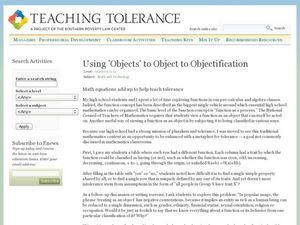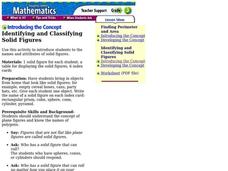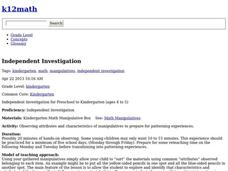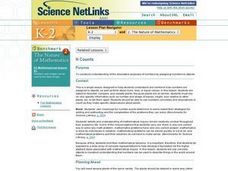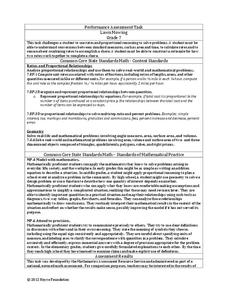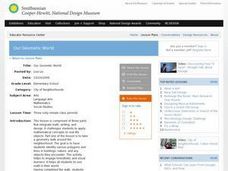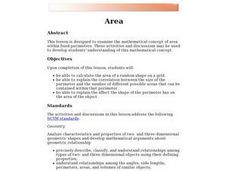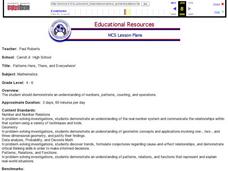Curated OER
Sorting and Classifying Outdoors
Students use their math skills of sorting and classifying with materials they collect outdoors. In this early childhood math lesson, students participate in a treasure hunt to gather item in nature and categorize their finds.
Curated OER
Classification And Identification
Students explore diagrammatic and taxonomic keys and their application in the marine sciences. They sort and classify objects and organisms based on visual attributes.
Curated OER
Using Objects to Object to Objectification
Students use math functions in part to complete a metaphorical lesson on tolerance. In this math and tolerance lesson, students receive rows of functions and try to find a single simple shared property without success. Students then...
Curated OER
Identifying and Classifying Solid Figures
Students identify and classify solid geometric figures. In this geometry lesson, students bring in objects that look like solid shapes and identify their attributes. Students identify the number of surfaces and faces on each figure.
Curated OER
Identify, Sort, Classify
Students identify, sort, and classify. For this kindergarten math lesson, students explore visual examples of sorting with 1 or more attributes. Students also practice solving problems that their instructors model.
Curated OER
Shoeless Math
First graders sort and classify, and complete a T-chart using Students' shoes.
Curated OER
Independent Investigation
Students classify objects. In this math lesson, students sort and classify objects based on their characteristics. Students identify characteristics of objects.
Curated OER
Describing an Object's Position
Learners explore language arts by participating in a shape identification activity. In this geometry shape lesson, students discuss the vocabulary terms used to describe the location of an object. Learners complete a worksheet based upon...
Curated OER
It Counts
Young scholars classify and compare plants using specific information, observations, and numbers. In this mathematical inquiry lesson, students use plant characteristics to describe, compare, and classify them. They attempt to develop a...
Ohio Department of Education
Describing and Creating Plane Figures - Grade One
Young mathematicians draw, create, and describe different shapes using triangles. They discuss attributes of the original and created shapes. Pupils classify the created shapes and draw and write in mathematics journals to communicate...
American Statistical Association
A Sweet Task
Candy is always an effective motivator! A fun math activity uses M&M's and Skittles to explore two-way frequency tables and conditional probability. The candy can serve a dual purpose as manipulatives and experimental data.
Curated OER
Relating Algebra to Geometry
Learners investigate the connection that exists between Algebra and Geometry. They classify two and three-dimensional figures. Pupils use formulas to solve problems in geometry and use appropriate measuring devices in the right contexts.
Curated OER
Worksheet 29 - Interval
For this interval worksheet, students find integrals of functions, use the first derivative test to classify points, and find the local and global extrema. This one-page worksheet contains eight multi-step problems.
Curated OER
Sorting Objects
Students sort objects by color. In this classification lesson, students identify the color of the objects and categorize them according to color.
Pennsylvania Department of Education
Exploring Likenesses and Differences of Objects
Students explore how to use similarities and differences when sorting objects. In this exploring likenesses and differences of objects activity, students examine ways to classify objects. Students make connections and classify...
Curated OER
Classification
Students investigate how different types of food can be classified then counted. In this sorting, arranging, and classifying lesson plan, students explore how to group foods based on commonalities. Students are asked four questions which...
Noyce Foundation
Lawn Mowing
This is how long we mow the lawn together. The assessment requires the class to work with combining ratios and proportional reasoning. Pupils determine the unit rate of mowers and calculate the time required to mow a lawn if they work...
Curated OER
Patterns Everywhere!
Learners recognize and demonstrate the patterning of numbers and objects in our environment. They create a pattern using geometric shapes and find a missing number in a sequence.
Curated OER
Geo Jammin' - Day 2, Lesson 4: Sing a Song of Shapes
Students learn five songs to define and develop understanding of the attributes of two- and three-dimensional figures and the meaning of mathematical terms. They classify objects as either two- or three-dimensional, through the use of...
Curated OER
Our Geometic World
Students walk around the neighborhood and identify various polygons and lines in buildings, nature and other objects. They design a building using various geometric patterns, shapes and lines. Students complete a descriptive writing of...
Curated OER
Area Applet
Elementary math classes calculate the area of a shape and explain the correlation between the size of the perimeter and the areas that can be contained within that perimeter. They also explain the effect the shape of the perimeter has on...
Curated OER
Patterns Here, There and Everywhere
Pattern recognition is a skill often used in mathematics. Learners count and sort manipulatives, organize the data into a graph and answer questions about the information displayed. They collect the objects to be used and create patterns...
Curated OER
Tetrahedron Kites
Let's go fly a kite! Discuss the concept of two-dimensional and three-dimensional objects with your math class. They examine a triangle and discuss the face, vertices, edges, and angles. Then they build their own Tetrahedral Kites and...
Curated OER
Relations
Pupils identify, compare, and analyze shapes and numbers. In this analogies and comparison math lesson, students warm up by completing 4 worksheets to familiarize themselves with analogies. In small groups, pupils are challenged to...




